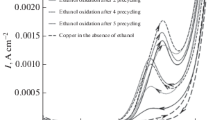Abstract
The potentialities of electrochemical method of removal of adsorbed octanethiol layer from gold electrode surface are considered. The dependence of a degree of gold macro- and microelectrode cleaning on the electrolyte composition, potential cycling range, and the number of cycles is studied. It is shown that the commonly used method of cleaning by multiple potential cycling in the perchloric acid solution in the potential range from 0 to 1400 mV (SCE) is not sufficiently efficient. Cycling in the water-ethanol solution of perchloric acid promotes the octanethiol desorption and leads to the complete regeneration of surface even after 6–8 cycles. This is evidenced by comparing with the voltammograms, which were obtained on pure Au surface in 4 mM potassium ferri-ferrocyanide and 0.1 M HClO4 solutions. A range of ethanol concentrations, which provides the highest degree of gold surface cleaning, is determined. The electrochemical method of cleaning by using water-ethanol solution of perchloric acid enables one to perform multiple electrode regeneration without destruction of thin gold layer (for example, in the quartz microbalance), which takes place in the case of chemical regeneration in the “piranha” solution based on sulfuric acid and hydrogen peroxide.
Similar content being viewed by others
References
Love, J.C., Estroff, L.A., Kriebel, J.K., Nuzzo, R.G., and Whitesides, G.M., Chem. Rev., 2005, vol. 105, p. 1103.
Iost, R.M. and Crespilho, F.N., Biosens. Bioelectron., 2012, vol. 31, p. 1.
Gooding, J.J. and Ciampi, S., Chem. Soc. Rev., 2011, vol. 40, p. 2704.
Chaki, N.R. and Vijayamohanan, K., Biosens. Bioelectron., 2002, vol. 17, p. 1.
Beulen, M.W.J., Kastenberg, M.I., van Veggel, F., and Reinboudt, D.N., Langmuir, 1998, vol. 14, p. 7463.
Wnuk, T., Chem. Eng. News, 1990, vol. 68, p. 26.
Johnson, B.N. and Mutharasan, R., J. Phys. Chem. C, 2013, vol. 117, no. 3, p. 1335.
Carvalhal, R.F., Freire, R.S., and Kubota, L.T., Electroanalysis, 2005, vol. 17, p. 1251.
Sauerbrey, G., Z. Phys., 1959, vol. 155, p. 206.
Zelinskii, A.G. and Bek, R.Yu., Elektrokhimiya, 1985, vol. 21, p. 66.
Michri, A.A., Pshenichnikov, A.G., and Burshtein, R.Kh., Elektrokhimiya, 1972, vol. 8, p. 364.
Rogozhnikov, N.A. and Bek, R.Yu., Elektrokhimiya, 1987, vol. 23, p. 1440.
Yang, D.-F., Wilde, C.P., and Morin, M., Langmuir, 1996, vol. 12, p. 6570.
Stolberg, L., Lipkowski, J., and Irish, D.E., J. Electroanal. Chem., 1990, vol. 296, p. 171.
Mirsky, V.M., Trends Anal. Chem., 2002, vol. 21, p. 439.
Vandler, D. and Kraus-Ophir, S., J.Solid State Electrochem., 2011, vol. 15, p. 1535.
Byloos, M., Al-Maznai, H., and Morin, M., J. Phys. Chem. B, 1999, vol. 103, p. 6554.
Yang, D.-F., Al-Maznai, H., and Morin, M., J. Phys. Chem. B, 1997, vol. 101, p. 1158.
Wong, E.H.J., May, G.L., and Wilde, C.P., Electrochim. Acta, 2013, vol. 109, p. 67.
Cai, J. and Baldelli, S., J. Phys. Chem. C, 2011, vol. 115, p. 19178.
Dai, J., Li, Zh., Jin, J., Cheng, J., Kong, J., and Bi, Sh., J. Electroanal. Chem., 2008, vol. 648, p. 315.
Ovchinnikova, S.N. and Medvedev, A.Zh., Abstracts of Papers of Int. Joined Conf.: V Konf. “Sovremennye metody v teoreticheskoi i eksperimental’noi elektrokhimii” (V Conf. “Modern Methods in Theoretical and Experimental Electrochemistry”) and IV Konf. “Elektrokhimicheskie i elektrolitno-plazmennye metody modifikatsii metallicheskikh poverkhnostei” (IV Conf. “Electrochemical and Electrolyte-Plasma Methods of Metal Surface Modification”), Ivanovo: Krestov Institute of Chemistry of Solutions, Russian Academy of Sciences, 2013, p. 147.
Author information
Authors and Affiliations
Corresponding author
Additional information
Original Russian Text © S.N. Ovchinnikova, A.Zh. Medvedev, 2015, published in Elektrokhimiya, 2015, Vol. 51, No. 4, pp. 339–346.
Rights and permissions
About this article
Cite this article
Ovchinnikova, S.N., Medvedev, A.Z. Desorption of octanethiol from gold electrode surface during its electrochemical cleaning. Russ J Electrochem 51, 287–293 (2015). https://doi.org/10.1134/S1023193515040084
Received:
Published:
Issue Date:
DOI: https://doi.org/10.1134/S1023193515040084




